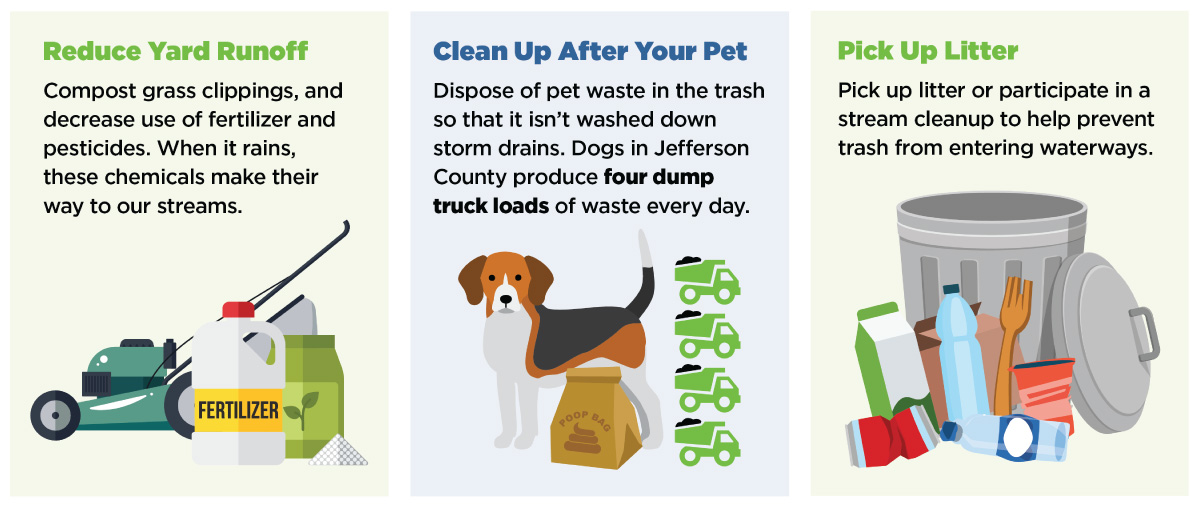What is a stream?
A stream is a small body of water with flowing surface water. A stream can be permanent or seasonal depending on the source of its water and the surrounding environment. There are three types of streams: perennial, intermittent, and ephemeral.
Perennial Stream: Stream that has flowing water year-round during a typical year. The water table is located above the stream bed for most of the year. Groundwater is the primary source of water for stream flow and runoff from rainfall is a supplemental source of water for stream flow.
Intermittent Stream: Stream that has flowing water during certain times of the year, when groundwater provides water for stream flow. During dry periods, they may not have flowing water. Runoff from rainfall is a supplemental source of water for stream flow.
Ephemeral Stream: Stream that only has flowing water during, and for a short duration after, rain events in a typical year. Their stream beds are located above the water table year-round. Runoff from rainfall is the primary source of water for stream flow.
The materials making up the bottom of a stream are known as the substrate. The substrate differs throughout the parts of a stream. The parts of a stream are normally characterized by riffles, runs, and pools. A riffle is the shallow area within a stream where the flow of water is constricted and forced over rocks and ledges. A pool is characterized by deeper, slow moving water and contains finer substrates. A run is an area between a riffle and pool where water flows a little quicker but is not broken up by rocks and ledges.
Streams in Jefferson County
Jefferson County has 11 major stream systems. The land drained by each of these streams is called a watershed. The 11 watersheds in Jefferson County are: Harrods Creek, Goose Creek, Muddy Fork Beargrass Creek, Middle Fork Beargrass Creek, South Fork Beargrass Creek, Floyds Fork, Cedar Creek, Pennsylvania Run, Pond Creek, Mill Creek, and the Ohio River.

Urban Stream Challenges
In urban areas like Jefferson County, streams are often modified to fit the community’s wants and needs. The health of our streams is impacted by both natural and human influences. Streams were relocated or channelized due to development which caused water quality concerns to arise. The increase in impervious surfaces leads to increased runoff during rain events and can result in more pollutants reaching our waterways. Urban streams are also more susceptible to sedimentation, increased temperatures, habitat changes, and loss of biodiversity.
To learn more about how impacts to our waterways have changed over time, visit The History of Our Streams page.
There are two main types of pollution that can impact our water quality: point source and non-point source pollution.
Point Source Pollution
Point source pollution can be defined as pollution that enters a stream or river at a defined location. Examples of point source pollution can be:
Louisville MSD continues to make efforts to reduce point source pollution in the community. MSD’s Water Quality Treatment Centers are regulated by the National Primary Discharge Elimination System (NPDES) program which helps ensure discharge does not harm water quality or human health. Additionally, MSD’s Integrated Overflow Abatement Plan (IOAP) defines sewer overflow reduction projects as part of the Federal Consent Decree. MSD has eliminated a number of sanitary and combined sewer overflows and taken small package treatment plants offline but work still remains to be done.
Non-Point Source Pollution
Non-point source pollution occurs when rainfall runs over land or through the ground, picks up pollutants and deposits them in streams, rivers and lakes. To learn more about non-point source pollution and how you can help, visit our Healthy Watershed Initiative page.
You can make a difference in the health of our streams.



